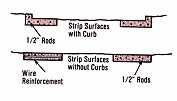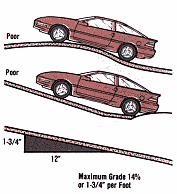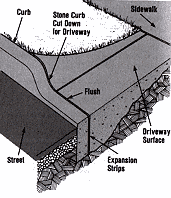 An alternative to the basic slab driveway is the strip driveway. It has one strip of concrete under each wheel, approximately 3' to 4' wide and about 5' center to center, with space between the strips. One caution with this type of driveway, however, is that it shifts more easily with changes in ground conditions than the slap type. It therefore requires some type of reinforcement, preferably iron or steel rebar. An alternative to the basic slab driveway is the strip driveway. It has one strip of concrete under each wheel, approximately 3' to 4' wide and about 5' center to center, with space between the strips. One caution with this type of driveway, however, is that it shifts more easily with changes in ground conditions than the slap type. It therefore requires some type of reinforcement, preferably iron or steel rebar.
 
Driveway thickness depends solely on the weight of the vehicles that will be using it. If it will serve only passenger cars, 4" is sufficient. If, on the other hand, trucks and other heavy vehicles will be using the driveway, a thickness of 5" or 6" is recommended.
|
Driveway Grade
Driveway grade must be carefully planned if the garage is located above or below the street level. A 14% grade (1-3/4" vertical rise for each running foot) is the recommended maximum, and it should be done gradually to avoid scraping the bumper or underside of the vehicles. For drainage purposes, a driveway should always be sloped slightly toward the street; ¼" per running foot is sufficient. A crown or cross slope can be used for this purpose.
|
 |
|


|
When constructing a driveway after the street, curbs and public walks are in place, consult your local building codes; the part of the driveway between the street and the sidewalk is usually controlled by the local municipality. Permission must usually be obtained before you can cut away part of the curb to accommodate a driveway entrance. If the driveway is built before the public walk, it must meet the proposed sidewalk grade and then drop to meet the top of the curb or gutter. |
Adding a Curb
When adding a curb to the end of a driveway, drill two ½"-diameter hold into the driveway. These holes should be 3" deep and approximately 2' apart. Insert a 6" steel reinforcing rod in each hole. To construct the forms, stake a 2 x 8 flat against the edge of the driveway; the inside forms cannot be staked, so nail two short 2 x 4s perpendicular to the form, extending in toward the center of the driveway. Use bricks to weigh down the 2 x 4 supports. After pouring the concrete, round the inside edge of the curb with a trowel. This curb will be 6" wide and extend 4" above the driveway.
|
